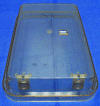Carbon dioxide and oxygen levels in disposable individually ventilated cages after removal from mechanical ventilation
- PMID: 22776114
- PMCID: PMC3314517
Carbon dioxide and oxygen levels in disposable individually ventilated cages after removal from mechanical ventilation
Abstract
Disposable individually ventilated cages have lids that restrict air exchange when the cage is not mechanically ventilated. This design feature may cause intracage CO2 to increase and O2 to decrease (hypercapnic and hypoxic conditions, respectively) when the electrical supply to the ventilated rack fails, the ventilated rack malfunctions, cages are docked in the rack incorrectly, or cages are removed from the ventilated rack for extended periods of time. We investigated how quickly hypercapnic and hypoxic conditions developed within disposable individually ventilated cages after removal from mechanical ventilation and compared the data with nondisposable static cages, disposable static cages, and unventilated nondisposable individually ventilated cages. When disposable individually ventilated cages with 5 adult mice per cage were removed from mechanical ventilation, CO2 concentrations increased from less than 1% at 0 h to approximately 5% at 3 h and O2 levels dropped from more than 20% at 0 h to 11.7% at 6 h. The breathing pattern of the mice showed a prominent abdominal component (hyperventilation). Changes were similar for 4 adult mice per cage, reaching at least 5% CO2 at 4 h and 13.0% O2 at 6 h. For 3 or 2 mice per cage, values were 4.6% CO2 and 14.7% O2 and 3.04% CO2 and 17.1% O2, respectively, at 6 h. These results document that within disposable individually ventilated cages, a hypercapnic and hypoxic microenvironment develops within hours in the absence of mechanical ventilation.
Figures







Similar articles
-
Carbon Dioxide, Oxygen, and Ammonia Levels in Mouse and Rat Disposable IVC Removed from Mechanical Ventilation.J Am Assoc Lab Anim Sci. 2022 Sep 1;61(5):432-440. doi: 10.30802/AALAS-JAALAS-22-000028. Epub 2022 Aug 31. J Am Assoc Lab Anim Sci. 2022. PMID: 36045005 Free PMC article.
-
Ammonia and carbon dioxide concentrations in disposable and reusable ventilated mouse cages.J Am Assoc Lab Anim Sci. 2008 Mar;47(2):57-62. J Am Assoc Lab Anim Sci. 2008. PMID: 18351723 Free PMC article.
-
Comparison of environment and mice in static and mechanically ventilated isolator cages with different air velocities and ventilation designs.Contemp Top Lab Anim Sci. 2004 Jan;43(1):14-20. Contemp Top Lab Anim Sci. 2004. PMID: 14984284
-
Microbiological monitoring in individually ventilated cage systems.Lab Anim (NY). 2004 Nov;33(10):36-41. doi: 10.1038/laban1104-36. Lab Anim (NY). 2004. PMID: 15514655 Free PMC article. Review.
-
Ammonia Measurement in the IVC Microenvironment.J Am Assoc Lab Anim Sci. 2019 Mar 1;58(2):184-189. doi: 10.30802/AALAS-JAALAS-18-000006. Epub 2019 Jan 31. J Am Assoc Lab Anim Sci. 2019. PMID: 30704550 Free PMC article. Review.
Cited by
-
Effect of Room Ventilation Rates in Rodent Rooms with Direct-Exhaust IVC Systems.J Am Assoc Lab Anim Sci. 2015 Sep;54(5):521-6. J Am Assoc Lab Anim Sci. 2015. PMID: 26424250 Free PMC article.
-
Nasal Histopathology and Intracage Ammonia Levels in Female Groups and Breeding Mice Housed in Static Isolation Cages.J Am Assoc Lab Anim Sci. 2015 Sep;54(5):478-86. J Am Assoc Lab Anim Sci. 2015. PMID: 26424245 Free PMC article.
-
Carbon Dioxide, Oxygen, and Ammonia Levels in Mouse and Rat Disposable IVC Removed from Mechanical Ventilation.J Am Assoc Lab Anim Sci. 2022 Sep 1;61(5):432-440. doi: 10.30802/AALAS-JAALAS-22-000028. Epub 2022 Aug 31. J Am Assoc Lab Anim Sci. 2022. PMID: 36045005 Free PMC article.
-
Evaluation of Various IVC Systems According to Mouse Reproductive Performance and Husbandry and Environmental Parameters.J Am Assoc Lab Anim Sci. 2022 Jan 1;61(1):31-41. doi: 10.30802/AALAS-JAALAS-21-000079. Epub 2022 Jan 3. J Am Assoc Lab Anim Sci. 2022. PMID: 34980294 Free PMC article.
References
-
- Berry RJ. 1968. The ecology of an island population of the house mouse. J Anim Ecol 37:445–470
-
- Campen MJ, Tagaito Y, Jenkins TP, Balbir A, O'Donnell CP. 2005. Heart rate variability responses to hypoxic and hypercapnic exposures in different mouse strains. J Appl Physiol 99:807–813 - PubMed
-
- Campen MJ, Tagaito Y, Li J, Balbir A, Tankersley CG, Smith P, Schwartz A, O'Donnell CP. 2004. Phenotypic variation in cardiovascular responses to acute hypoxic and hypercapnic exposure in mice. Physiol Genomics 20:15–20 - PubMed
-
- Floyd BN, Leske DA, Wren SM, Mookadam M, Fautsch MP, Holmes JM. 2005. Differences between rat strains in models of retinopathy of prematurity. Mol Vis 11:524–530 - PubMed
Publication types
MeSH terms
Substances
LinkOut - more resources
Full Text Sources
